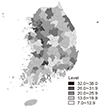Abstract
Objectives
The purpose of this study was to interpret regional disparities in the number of teeth sealed with pit and fissure sealants, identify the factors that affect these disparities and find solutions for the same.
Methods
Data were collected from the National Health Insurance Service and Korean statistical information service using metropolis-city-rural area dental health infrastructure variables, regional health behavior variables, and local finance-related variables.
Results
In 2015, the number of teeth sealed with pit and fissure sealants per 100 people was higher in the metropolis or city than in the rural area. There was a positive correlation between the number of teeth sealed with pit and fissure sealants and the number of dentists, dental hygienists, dental institutions, standardization rate of subjective awareness of well-being, standardization rate of brushing after lunch, and the proportion of welfare budget in the general budget. There was a negative correlation with the annual standardization rate of health institution use, the standardization rate of unused medical services, and the local government's financial independence. According to the final model of the multiple regression analysis, while the impact of infrastructure on dentistry was not statistically significant, the statistical significance of standardization rate of brushing after lunch, the local government's financial independence, and the proportion of welfare budget in the general budget were maintained.
Conclusions
To reduce regional disparities in the volume of use of pit and fissure sealants, it was concluded that it may be effective to select regions with a consideration of the level of regional economic power, implement separate and appropriate policies and projects, and improve the awareness in residents.
Figures and Tables
Table 1
The community-level variables in this study

*Number of pit and fissure sealant/Number of resident registration population of 5–18 year olds×100.
†Number of dentists×10,000/Number of resident registration population.
‡Number of dental hygienists×10,000/Number of resident registration population.
§Number of dental institution×10,000/Number of resident registration population.
References
1. Korea Ministry of Government Legislation[Internet]. cited 2018 Feb 27. Available from: http://www.law.go.kr/LSW/nwRvsLsInfoR.do?lsiSeq=197775.
2. Choi JS, Park DY, Jung SH. The relationship between pit and fissure sealant(PFS) experienceand the socio-economic factors of adolescents before and after coverage by National Health Insurance(NHI). J Korean Acad Oral Health. 2017; 41:116–121.

3. Choi JS, Ma DS, Jung SH, Cho EP, Park DY. Changes in the amount of pit and fissure sealants supplied in Korea after inclusion in the National Health Insurance coverage. J Korean Acad Oral Health. 2015; 39:69–77.

4. Lee HJ, Bae KH. A change in the regional disparity based on the national insurance coverage of dental sealant in Korea. J Korean Acad Oral Health. 2014; 38:165–169.

5. Takano T, Nakamura K. An analysis of health levels and various indicators of urban environments for healthy cities projects. J Epidemiol Community Health. 2001; 55:263–270.

6. Wen PC, Lee CB, Chang YH, Ku LE, Li CY. Demographic and ruralurban variations in dental service utilization in Taiwan. Rural Remote Health. 2017; 17:4161.

7. Ompad DC, Galea S, Caiaffa WT, Vlahov D. Social determinants of the health of urban populations: methodologic considerations. J Urban Health. 2007; 84:i42–i53.

8. Cho WH, Kim HJ. Small area variation. Korean J Health Policy Adm. 1991; 1:42–53.
9. Lee YJ. An study on the inequality of health care resources distribution affected by regional characteristics. J Crit Soc Welf. 2005; 12:49–78.
10. Statistical geographic information service. Applicaions. Statistics Map Experience[Internet]. cited 2017 May 03. Available from: https://sgis.kostat.go.kr/statexp/index.vw.
11. Health insurance review & assessment service. International cooperation[Internet]. cited 2017 May 03. Available from: https://sgis.kostat.go.kr/statexp/index.vw.https://www.hira.or.kr/dummy.do?pgmid=HIRAA030060000000&cmsurl=/cms/medi_info/02/01/1343482_27565.html&subject=%EC%B9%98%EB%A9%B4%EC%97%B4%EA%B5%AC%EC%A0%84%EC%83%89%EC%88%A0%28%EC%B9%98%EC%95%84%ED%99%88%EB%A9%94%EC%9A%B0%EA%B8%B0%29.
12. Ministry of government legislation. About MOLEG[Internet]. cited 2018 Feb 03. Available from: http://www.moleg.go.kr/lawinfo/lawNotice/lawNoticeInfo;jsessionid=j6ubUS0zbIOOQxsKohhubKLezvWMs9217pqmkTg6ndGdmVGG9FGPcbB9DtQdGopW.moleg_a1_servlet_engine2?ogLmPpSeq=40726&mappingLbicId=0&announceType=TYPE5&pageIndex=&rowIdx=7.180531.
13. Liu J, Probst JC, Martin AB, Wang JY, Salinas CF. Disparities in dental insurance coverage and dental care among US children: the National Survey of Children's Health Pediatric. Pediatrics. 2007; 119:S12–S21.
14. Mashoto KO, Astrom AN, Skeie MS, Masalu JR. Socio-demographic disparity in oral health among the poor: a cross sectional study of early adolescents in Kilwa district, Tanzania. BMC Oral Health. 2010; 10:7.

15. Skinner AC, Slifkin RT, Mayer ML. The effect of rural residence on dental unmet need for children with special health care needs. J Rural Health. 2006; 22:36–42.

16. Lim DH. Ganghwa gugangbogeonsaeobui jinan 5nyeonganui unyeonggwa pyeongga(1997-2001)(Operation and evaluation of the last 5 years of the advertisement oral health program in Ganghwa). J Korean Dent Assoc. 2002; 40:680–685.
17. Ministry of the Interior and Safety[Internet]. cited 2018 Feb 03. Available from: https://www.gov.kr/portal/service/serviceInfo/PTR000053962.
18. Statistics Korea [Internet]. cited 2018 Feb 03. Available from: http://kosis.kr/statHtml/statHtml.do?orgId=568&tblId=DT_56801_K000018.
19. Department of Health. Publications[Internet]. cited 2018 Feb 03. Available from: http://webarchive.nationalarchives.gov.uk/20110802141501/http://www.dh.gov.uk/en/Publicationsandstatistics/Publications/PublicationsPolicyAndGuidance/DH_4101455.
20. Korea Ministry of Government Legislation[Internet]. cited 2018 May 17. Available from: http://www.law.go.kr/%EB%B2%95%EB%A0%B9/%EC%A7%80%EC%97%AD%EB%B3%B4%EA%B1%B4%EB%B2%95%EC%8B%9C%ED%96%89%EB%A0%B9.
21. Ministry of Health & Welfare. Je1cha gugangbogeonsaeob gibongyehoek(Basic plan for the 1st oral health program). Sejong: Ministry of Health & Welfare;2017. p. 23–24.
22. Kang AG. An analysis of the equity in health service utilization with the regional distribution of health care resources. Korean Soc Secur Stud. 2007; 23:189–219.
23. Kim NH, Jeon JE, Chung WG, Kim DK. Social determinants related to the regional difference of unmet dental need in Korea. J Korean Acad Oral Health. 2012; 36:62–72.
24. Choi YH, Lee JH, Lee SG. Geographical disparities for oral health status in Korean adults. J Korean Acad Oral Health. 2009; 33:243–253.
25. Dahlgren G, DWhitehead M. Policies and Strategies to Promote Social Equity in Health. Stockholm, Sweden: Institute for Futures Studies;1991. p. 11–13.




 PDF
PDF ePub
ePub Citation
Citation Print
Print







 XML Download
XML Download